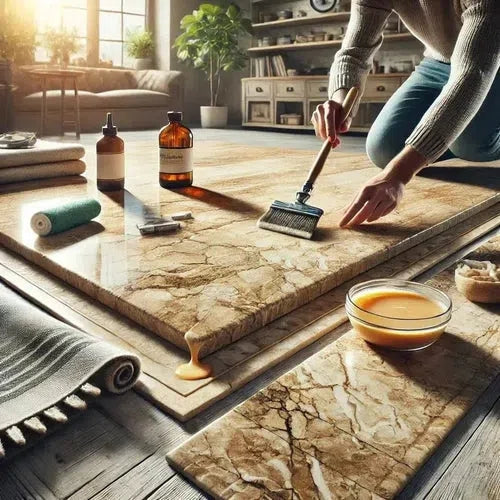How to Protect Travertine?

Travertine is one of the most sought-after natural stones, admired for its timeless beauty and versatility. Its unique patterns and warm, earthy tones make it a popular choice for everything from flooring and countertops to backsplashes and shower walls. However, like all natural stones, travertine requires proper care and maintenance to preserve its look and longevity. Protecting your travertine ensures that it remains as beautiful as the day it was installed, and this guide will walk you through the essential steps needed to keep it in top condition.
Regular Cleaning: The Foundation of Protection
The first and most basic step in protecting travertine is regular cleaning. Dust, dirt, and debris can act like fine sandpaper on the surface of your travertine, leading to scratches and wear over time. For floors, it’s crucial to sweep or vacuum frequently to remove any particles that could cause damage. For countertops and other surfaces, a damp cloth should be used daily to wipe away spills and crumbs.
However, not all cleaning methods are suitable for travertine. Harsh chemicals, acidic substances, and abrasive materials should be avoided at all costs. These can damage the stone’s surface, leading to etching and dullness. Instead, opt for a pH-neutral cleaner specifically designed for natural stone. This will ensure that your travertine remains pristine without compromising its integrity.
Sealing: A Crucial Step in Travertine Care
Travertine is a porous stone, meaning it has small holes and channels throughout its structure. While this is part of what gives travertine its unique look, it also makes the stone susceptible to staining and water absorption. To protect against these potential issues, sealing travertine is essential.
A high-quality, penetrating sealer should be applied to all travertine surfaces. The sealer works by filling in the stone’s pores, creating a barrier that prevents liquids from seeping in and causing stains or damage. Depending on the amount of traffic or exposure to water your travertine experiences, you may need to reseal it every 6 to 12 months. A good rule of thumb is to perform a water test: If water no longer beads on the surface but instead absorbs into the stone, it’s time to reseal.
Avoiding Damage: What Not to Do
While travertine is durable, it is not invincible. Certain substances and activities can cause irreversible damage to the stone. Acidic liquids like vinegar, lemon juice, and wine can etch the surface, leaving dull spots that are difficult to remove. Similarly, abrasive cleaners and rough scrubbing pads can scratch and wear down the stone’s finish.
To avoid these issues, always use mild, stone-safe cleaning products. When spills occur, particularly those involving acidic substances, clean them up immediately to prevent any potential damage. Additionally, consider using coasters, trivets, and placemats to protect countertops from heavy or hot items.
Preventing Scratches and Wear
Although travertine is a relatively hard stone, it is still prone to scratches, especially in high-traffic areas. To minimize this risk, use rugs or mats in entryways and other areas where dirt and debris are likely to be tracked in. For furniture placed on travertine floors, consider using felt pads on the legs to prevent scratching when the furniture is moved.
If scratches do occur, they can often be polished out by a professional. However, deep scratches may require more extensive repair, so it’s best to prevent them from happening in the first place.
Routine Inspections and Maintenance
Regular inspections are key to catching any potential issues with your travertine before they become major problems. Look for signs of wear, such as dull spots, scratches, or cracks. If you notice any of these, it’s important to address them promptly.
For minor issues, such as small cracks or chips, a natural stone filler can often be used to make repairs. However, more significant damage may require the expertise of a professional stone restoration specialist. By staying vigilant and performing routine maintenance, you can extend the life of your travertine and keep it looking beautiful for years to come.
Conclusion
Travertine is a stunning natural stone that can add elegance and charm to any space. With its unique texture and beautiful color variations, it’s no wonder that so many homeowners choose travertine for their homes. However, to ensure that your travertine remains in top condition, it’s important to take proper care of it. Regular cleaning, sealing, and careful handling are all essential components of travertine maintenance. By following the steps outlined in this guide, you can protect your investment and enjoy the timeless beauty of travertine for many years to come.


Leave a comment